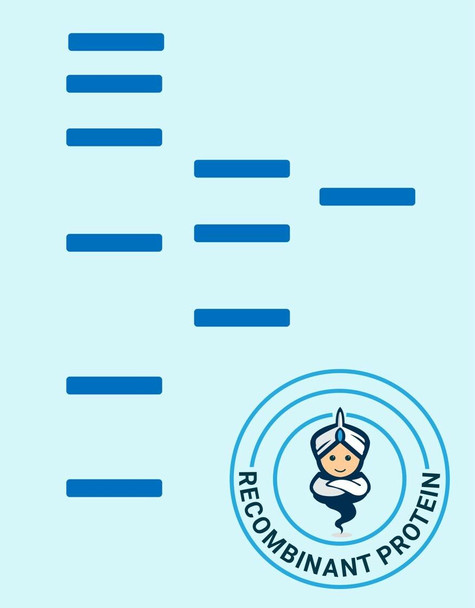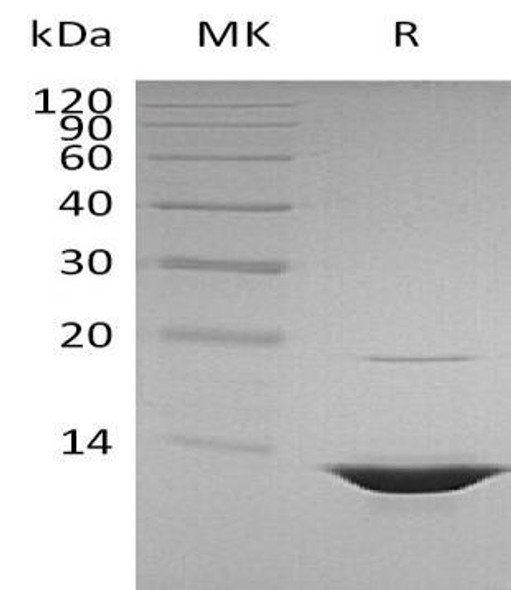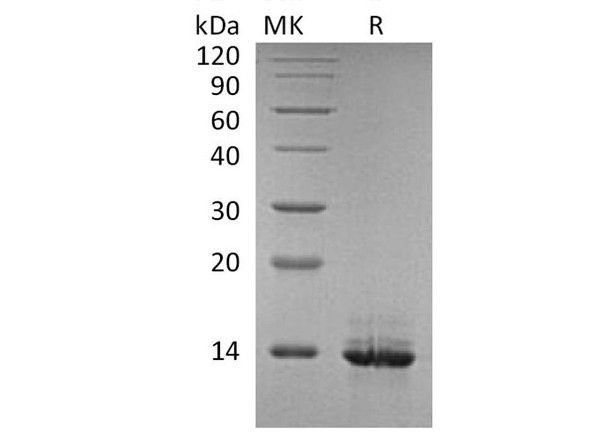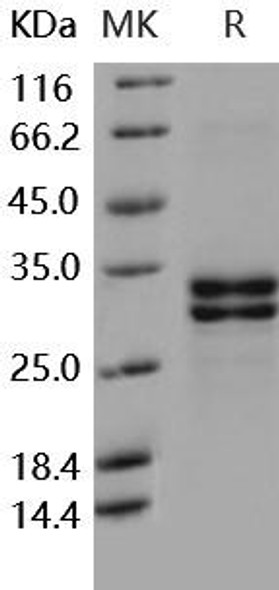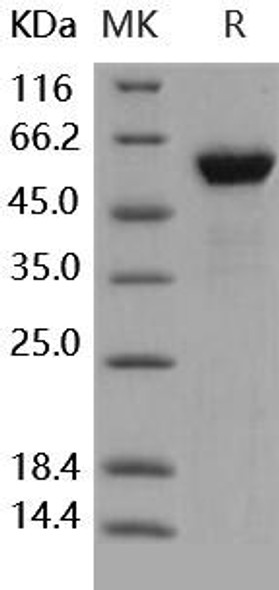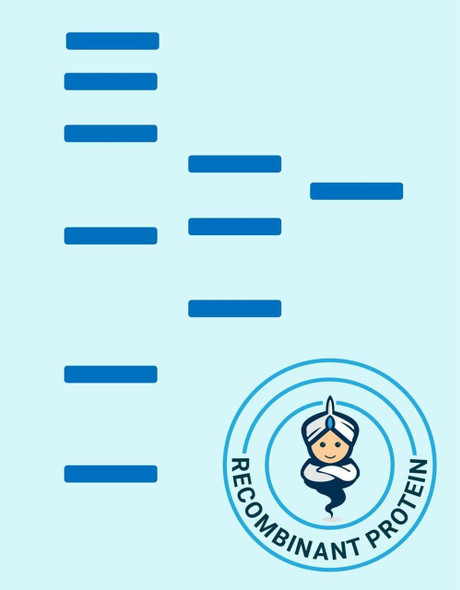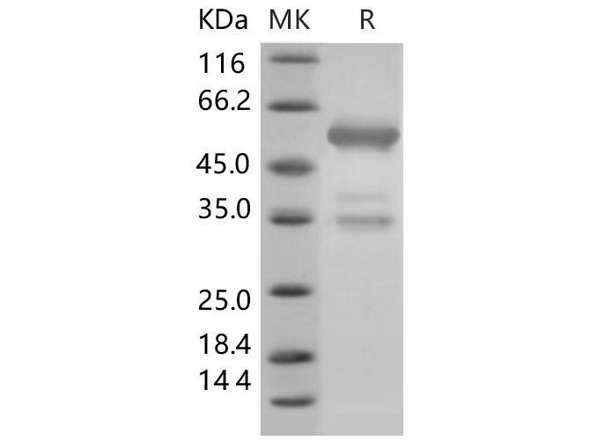Description
| Product Name: | Human HMGB1 Recombinant Protein |
| Product Code: | RPPB3698 |
| Size: | 20µg |
| Species: | Human |
| Target: | HMGB1 |
| Synonyms: | HMG1, HMG3, SBP-1, Amphoterin, HMGB1, High-Mobility Group Box 1. |
| Source: | Hi-5 cells |
| Physical Appearance: | Sterile Filtered colorless solution. |
| Formulation: | The HMG1 solution (1mg/ml) contains 20mM Tris-HCl pH-8, 1mM EDTA, 0.5mM DTT and 10% glycerol. |
| Stability: | Store at 4°C if entire vial will be used within 2-4 weeks. Store, frozen at -20°C for longer periods of time. For long term storage it is recommended to add a carrier protein (0.1% HSA or BSA).Avoid multiple freeze-thaw cycles. |
| Purity: | Greater than 90% as determined by SDS-PAGE. |
| Amino Acid Sequence: | MGKGDPKKPR GKMSSYAFFV QTCREEHKKK HPDASVNFSE FSKKCSERWK TMSAKEKGKF EDMAKADKAR YEREMKTYIP PKGETKKKFK DPNAPKRPPS AFFLFCSEYR PKIKGEHPGL SIGDVAKKLG EMWNNTAADD KQPYEKKAAK LKEKYEKDIA AYRAKGKPDA AKKGVVKAEK SKKKKEEEED EEDEEDEEEE EDEEDEDEEE DDDDELEHHH HHH |
HMGB1 is an abundant chromatin-binding protein found in eukaryotic cell nucleus and acts in the assembly of nucleoprotein complexes. Inside the cell, HMGB1 binds to DNA and is involved in transcriptional regulation. Outside the cell, HMGB1 acts as a cytokine with activities that resemble those of tumor necrosis factor (TNF). HMGB1 is elevated significantly in chronic kidney disease patients and correlates with glomerular filtration rate as well as with markers of inflammation and malnutrition. HMGB1 is involved in Gram-negative sepsis by catalyzing movement of LPS monomers from LPS aggregates to CD14 to initiate a TLR4-mediated proinflammatory response. HMGB1 plays an important role in the relationship between necrosis and malignancy in glioma tumours. HMG1 protein is induced by Mycobacterium bovis BCG. Overexpression of HMGB1 is common in gastrointestinal stromal tumors and is related to the KIT mutation. HMG1 induces growth inhibition and apoptosis in macrophages through RAGE intracellular signaling pathway. The increase of extracellular HMGB1 observed in salivary glands of Sjogren's syndrome patients indicates that HMGB-1 is involved in the inflammatory process of the disease. HMGB-1 together with estrogen increase cell cycle progression in tumor cell lines.
HMG1 Human Recombinant fused to an 8 aa His-Tag at C-terminus produced in High Five insect cells is a single, glycosylated, polypeptide chain (amino acids 1-215) containing 223 amino acids and having a molecular mass of 25 kDa.The HMGB1 is purified by proprietary chromatographic techniques.
| UniProt Protein Function: | Multifunctional redox sensitive protein with various roles in different cellular compartments. In the nucleus is one of the major chromatin-associated non-histone proteins and acts as a DNA chaperone involved in replication, transcription, chromatin remodeling, V(D)J recombination, DNA repair and genome stability. Proposed to be an universal biosensor for nucleic acids. Promotes host inflammatory response to sterile and infectious signals and is involved in the coordination and integration of innate and adaptive immune responses. In the cytoplasm functions as sensor and/or chaperone for immunogenic nucleic acids implicating the activation of TLR9-mediated immune responses, and mediates autophagy. Acts as danger associated molecular pattern (DAMP) molecule that amplifies immune responses during tissue injury (PubMed:27362237). Released to the extracellular environment can bind DNA, nucleosomes, IL-1 beta, CXCL12, AGER isoform 2/sRAGE, lipopolysaccharide (LPS) and lipoteichoic acid (LTA), and activates cells through engagement of multiple surface receptors. In the extracellular compartment fully reduced HMGB1 (released by necrosis) acts as a chemokine, disulfide HMGB1 (actively secreted) as a cytokine, and sulfonyl HMGB1 (released from apoptotic cells) promotes immunological tolerance (PubMed:23519706, PubMed:23446148, PubMed:23994764, PubMed:25048472). Has proangiogdenic activity. May be involved in platelet activation. Binds to phosphatidylserine and phosphatidylethanolamide. Bound to RAGE mediates signaling for neuronal outgrowth. May play a role in accumulation of expanded polyglutamine (polyQ) proteins such as huntingtin (HTT) or TBP (PubMed:23303669, PubMed:25549101). |
| NCBI Summary: | This gene encodes a protein that belongs to the High Mobility Group-box superfamily. The encoded non-histone, nuclear DNA-binding protein regulates transcription, and is involved in organization of DNA. This protein plays a role in several cellular processes, including inflammation, cell differentiation and tumor cell migration. Multiple pseudogenes of this gene have been identified. Alternative splicing results in multiple transcript variants that encode the same protein. [provided by RefSeq, Sep 2015] |
| UniProt Code: | P09429 |
| NCBI GenInfo Identifier: | 123369 |
| NCBI Gene ID: | 3146 |
| NCBI Accession: | P09429.3 |
| UniProt Secondary Accession: | P09429,Q14321, Q5T7C3, Q6IBE1, A5D8W9, |
| UniProt Related Accession: | P09429 |
| Molecular Weight: | 24,894 Da |
| NCBI Full Name: | High mobility group protein B1 |
| NCBI Synonym Full Names: | high mobility group box 1 |
| NCBI Official Symbol: | HMGB1�� |
| NCBI Official Synonym Symbols: | HMG1; HMG3; HMG-1; SBP-1�� |
| NCBI Protein Information: | high mobility group protein B1 |
| UniProt Protein Name: | High mobility group protein B1 |
| UniProt Synonym Protein Names: | High mobility group protein 1; HMG-1 |
| Protein Family: | High mobility group protein |
| UniProt Gene Name: | HMGB1�� |

